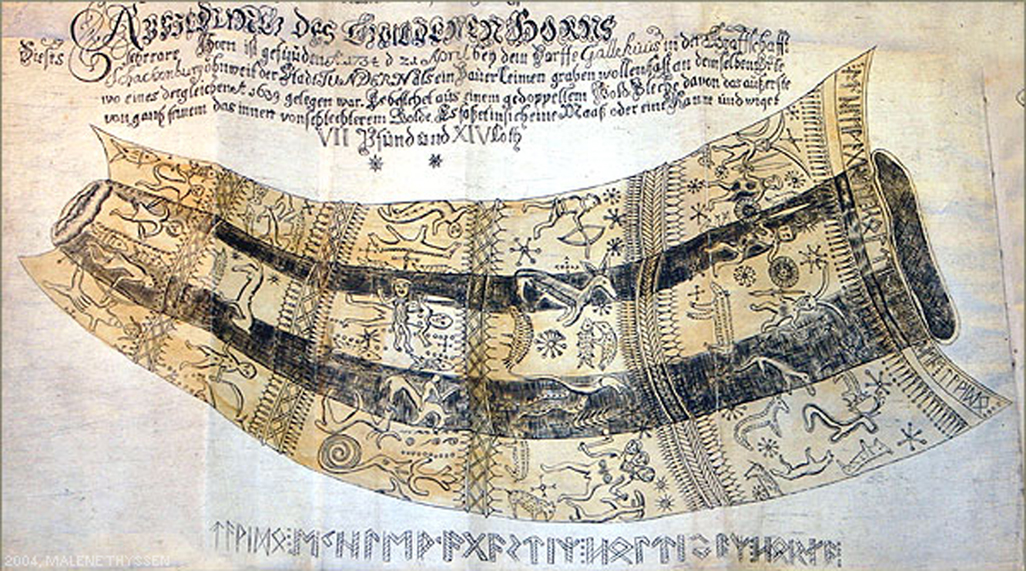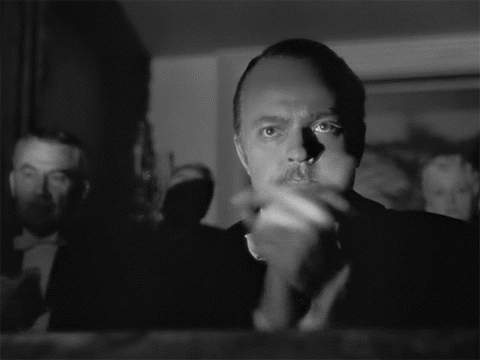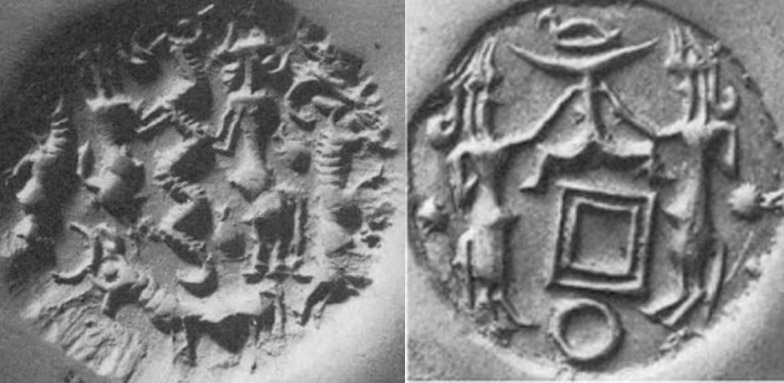It looks like you're using an Ad Blocker.
Please white-list or disable AboveTopSecret.com in your ad-blocking tool.
Thank you.
Some features of ATS will be disabled while you continue to use an ad-blocker.
26
share:
What if there was a magical Golden horn that could connect the upper Heavens, the Earth and the Underworld, what if it could even sound Ragnorak, and
what if it had even been found...
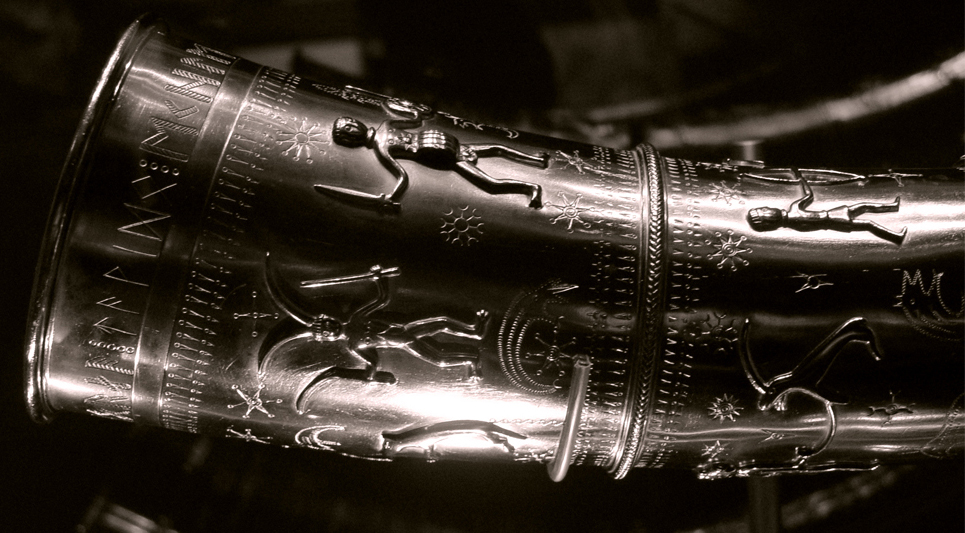
She knows that Heimdall's horn is hidden under the heaven-bright holy tree. A river she sees flow, with foamy fall, from Valfather's pledge. Understand ye yet, or what?
In terms then of what the horns were depicting of course people have struggled to understand, various suggestions of which Nordic Gods might be represented and constellations, but given familiarity with early Indo-European tradition and their adaptations of Northern Mesopotamian and Iranian traditions it seemed to myself that there was commonality involved with the successive layered symbolism of the horns and the successive symbolism that had been applied to the Tree of Life symbolism in Mesopotamia.
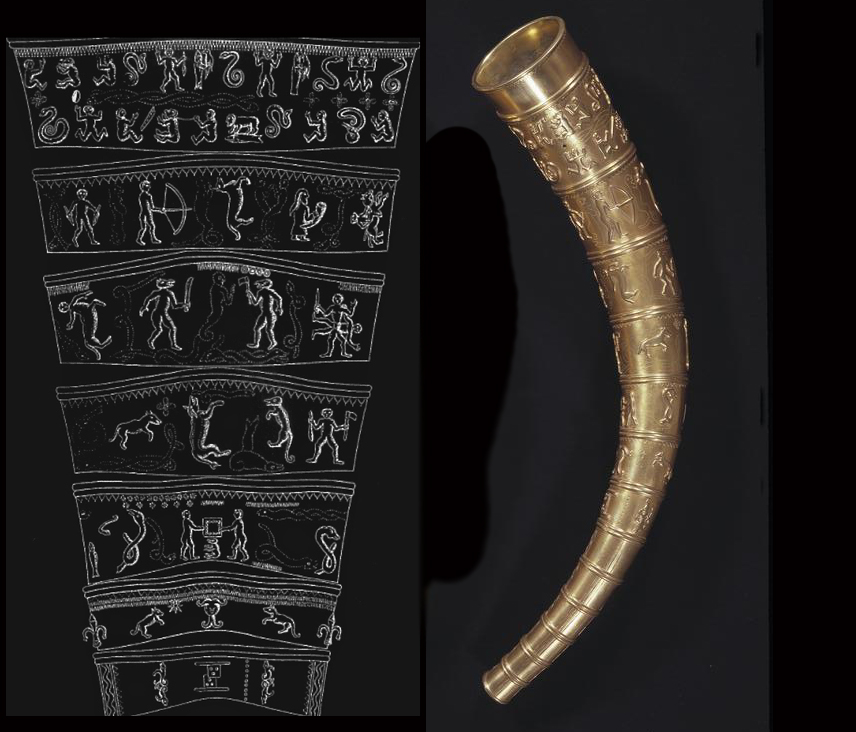
So in terms of the longer horn it was actually remarkable to see two figures either side of a square with the general company of serpents a motif i have sourced and considered a great deal, in Mesopotamia these would have represented Enki and Ninhurdag and their generation of Life, and the tree of such, at the Celestial location of the Field Constellation, the Pegasus square, with related constellations Pisces and Cetus the sea serpent.
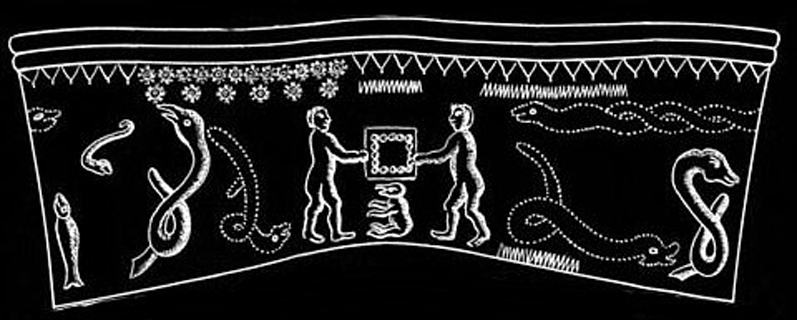
The idea of some representation based upon Enki iconography still having been around in 4th century Denmark is very exciting if you like that sort of thing, and there is further correct application as it was held that there were lower aspects of creation even before the establishment of the field and the basic organic compounds of life, in that the roots of their tree sourced to the Milky Way in the region of Scorpio-Antares were the Galactic Plane intersects the Milky Way, and that this drawing of the waters was regulated by the boar constellation Delphinus, between Pegasus and Scorpio, so these two lower layers we see also represented.
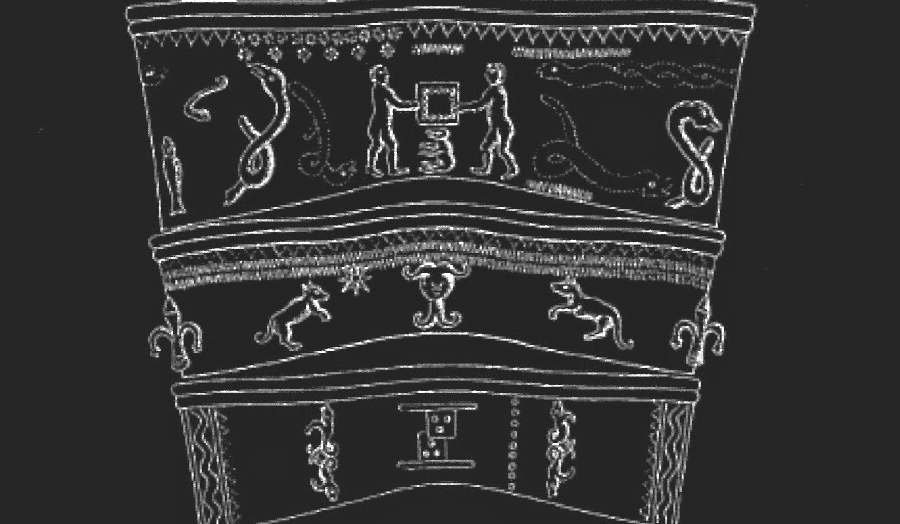
In general the successive layers of the Mesopotamian sacred tree were probably considered as seven, with the two lower stages that would be nine, which was the more important sacred number in Nordic tradition.
The three stages above the Pegasus square in Mesopotamian tradition were primarily Cetus-Andromeda-Perseus, were Cetus represented the first stages of development of organic life, in terms of close association between plant life and rudimentary aquatic, were Andromeda the development of more advanced and spiritually self aware life forms represented by the stag, and Perseus as the Panther in conflict with self and all other aspects of life in terms of self management and relationship toward others, looking at how the Danes have tried to suggest these complex considerations;
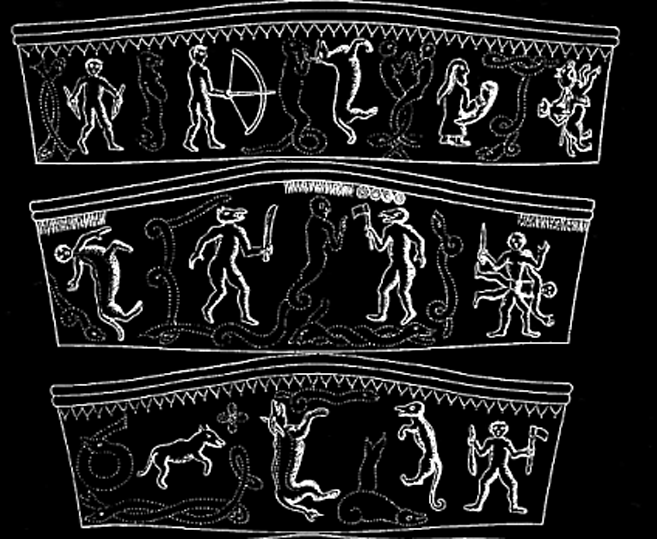
The symbols utilized seem quite different, but it can be noted at the Andromeda layer a curious ghost like soul is born and that in thelayer above this becomes two joined as one, they are seen to generate from the mysterious serpent like forms, it may also ne the case that gender sub-division is seen at the Andromeda stage, the two figures in cross form joined at the hip or lower rib, it also seems suggested that the individual soul at the second level may in some sense need to be rescued as it seems threatened, the escaping from fatalistic immersion within life through determinism, the way of the hunter seen with his bow and the woman with the drinking horn of the warrior.
The seventh level of that horn probably terminates at the level of Taurus, in Mesopotamia there could be two levels above this, but there was foundthe entrance into the Underworld and also were the ecliptic plane crossed the tree in the location of Aldebaran, so perhaps the numerous symbols seen there could related to the Planets and constellations of the ecliptic plane.
Comparing the second example with lower sections missing;
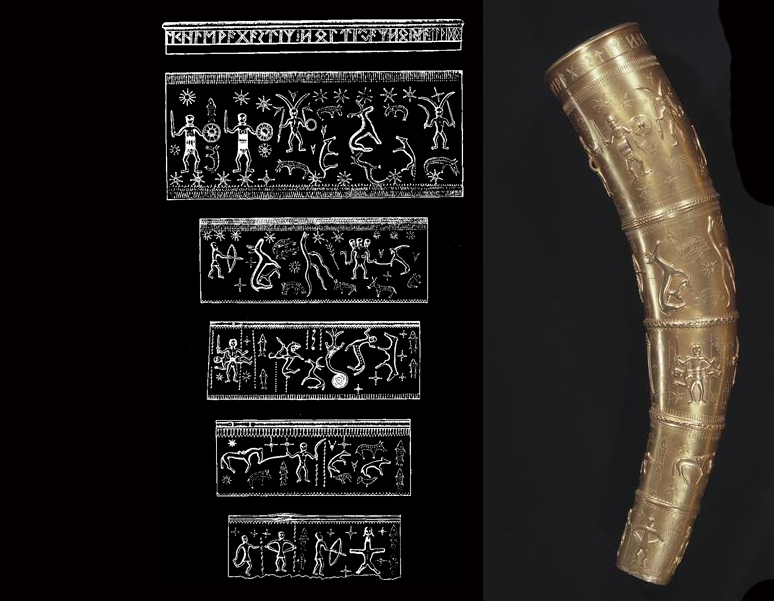
It some ways these more closely relate to expectations with regards to Pegasus as the heroes horse and the stag Andromeda, the lowest panel seems to involve the principle of the self sacrificed Deity, in this version the serpent form is much less seen.
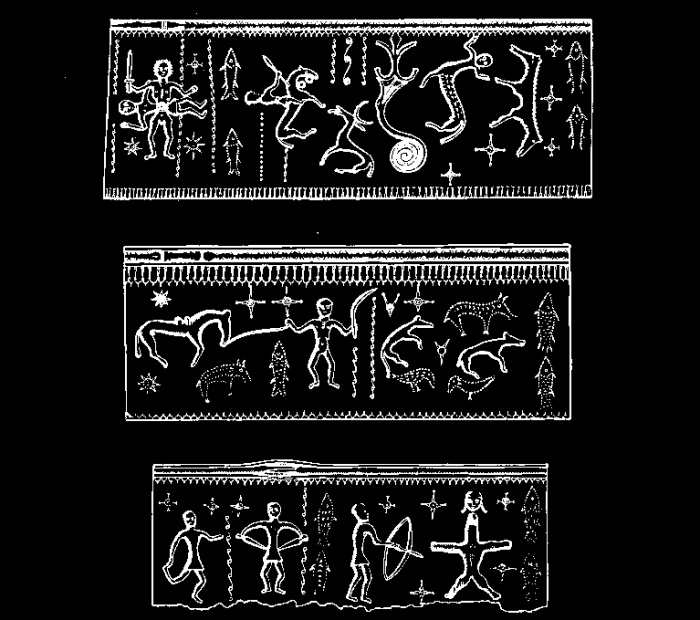
The upper panel is interesting in that the hero twins are seen, relating perhaps to the twins of Gemini through which the ecliptic plane progresses after Gemini, perhaps the Great Horned warrior is himself Taurus, the triple headed ogre is something of an oddity though in the Greek Perseus tradition there are the three sisters with some relationship to fate.
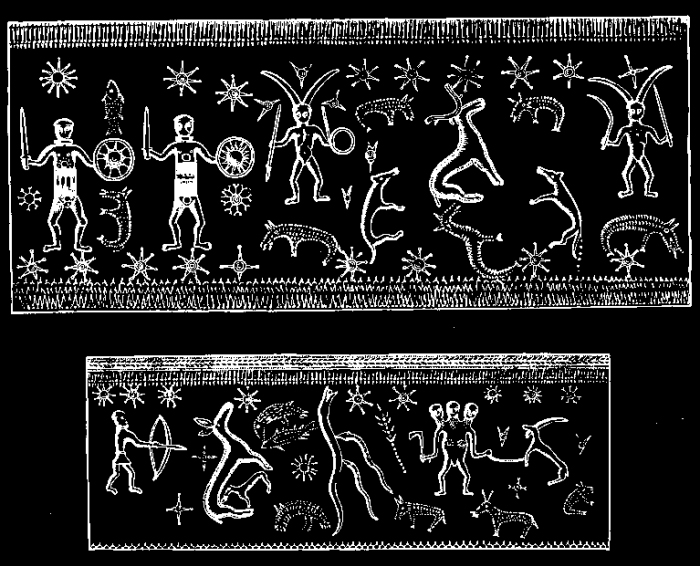
So that's something of a cursory examination of the sort of thing i think would be involved with the representations on these horns, that they maintained traditions dating back thousands of years and that they would have found common ground and understanding with the likes of the ancient Mesopotamians, a much more sophisticated tradition than is appreciated at present.
Mim's sons dance, but the central tree takes fire, at the resounding Giallar-horn. Loud blows Heimdall, his horn is raised;
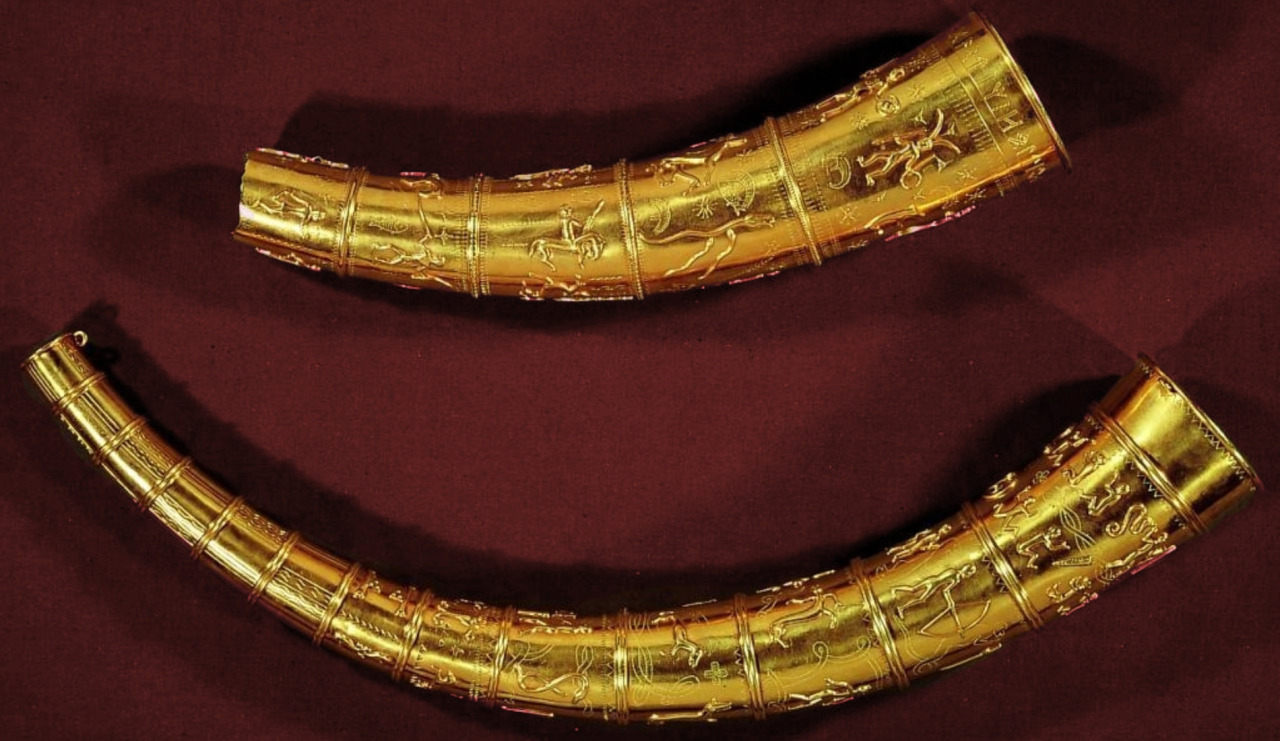

She knows that Heimdall's horn is hidden under the heaven-bright holy tree. A river she sees flow, with foamy fall, from Valfather's pledge. Understand ye yet, or what?
The Golden Horns of Gallehus were two horns made of sheet gold, discovered in Gallehus, north of Møgeltønder in Southern Jutland, Denmark. The horns date to the early 5th century
The horns were found in 1639 and in 1734, respectively, at locations only some 15–20 metres apart. They were composed of segments of double sheet gold.
The two horns were found incomplete; the longer one found in 1639 had seven segments with ornaments, to which six plain segments and a plain rim were added, possibly by the 17th-century restorer.
The shorter horn found in 1734 had six segments, a narrow one bearing a Proto-Norse Elder Futhark inscription at the rim and five ornamented with images
The longer horn was discovered on July 20, 1639 by a peasant girl named Kirsten Svendsdatter when she saw it protrude above the ground. She wrote a letter to King Christian IV of Denmark who retrieved it.
The runic inscription ek Hlewagastiz Holtijaz horna tawidō, translating to "I Hlewagastiz Holtijaz made the horn"
In terms then of what the horns were depicting of course people have struggled to understand, various suggestions of which Nordic Gods might be represented and constellations, but given familiarity with early Indo-European tradition and their adaptations of Northern Mesopotamian and Iranian traditions it seemed to myself that there was commonality involved with the successive layered symbolism of the horns and the successive symbolism that had been applied to the Tree of Life symbolism in Mesopotamia.

So in terms of the longer horn it was actually remarkable to see two figures either side of a square with the general company of serpents a motif i have sourced and considered a great deal, in Mesopotamia these would have represented Enki and Ninhurdag and their generation of Life, and the tree of such, at the Celestial location of the Field Constellation, the Pegasus square, with related constellations Pisces and Cetus the sea serpent.

The idea of some representation based upon Enki iconography still having been around in 4th century Denmark is very exciting if you like that sort of thing, and there is further correct application as it was held that there were lower aspects of creation even before the establishment of the field and the basic organic compounds of life, in that the roots of their tree sourced to the Milky Way in the region of Scorpio-Antares were the Galactic Plane intersects the Milky Way, and that this drawing of the waters was regulated by the boar constellation Delphinus, between Pegasus and Scorpio, so these two lower layers we see also represented.

In general the successive layers of the Mesopotamian sacred tree were probably considered as seven, with the two lower stages that would be nine, which was the more important sacred number in Nordic tradition.
The three stages above the Pegasus square in Mesopotamian tradition were primarily Cetus-Andromeda-Perseus, were Cetus represented the first stages of development of organic life, in terms of close association between plant life and rudimentary aquatic, were Andromeda the development of more advanced and spiritually self aware life forms represented by the stag, and Perseus as the Panther in conflict with self and all other aspects of life in terms of self management and relationship toward others, looking at how the Danes have tried to suggest these complex considerations;

The symbols utilized seem quite different, but it can be noted at the Andromeda layer a curious ghost like soul is born and that in thelayer above this becomes two joined as one, they are seen to generate from the mysterious serpent like forms, it may also ne the case that gender sub-division is seen at the Andromeda stage, the two figures in cross form joined at the hip or lower rib, it also seems suggested that the individual soul at the second level may in some sense need to be rescued as it seems threatened, the escaping from fatalistic immersion within life through determinism, the way of the hunter seen with his bow and the woman with the drinking horn of the warrior.
The seventh level of that horn probably terminates at the level of Taurus, in Mesopotamia there could be two levels above this, but there was foundthe entrance into the Underworld and also were the ecliptic plane crossed the tree in the location of Aldebaran, so perhaps the numerous symbols seen there could related to the Planets and constellations of the ecliptic plane.
Comparing the second example with lower sections missing;

It some ways these more closely relate to expectations with regards to Pegasus as the heroes horse and the stag Andromeda, the lowest panel seems to involve the principle of the self sacrificed Deity, in this version the serpent form is much less seen.

The upper panel is interesting in that the hero twins are seen, relating perhaps to the twins of Gemini through which the ecliptic plane progresses after Gemini, perhaps the Great Horned warrior is himself Taurus, the triple headed ogre is something of an oddity though in the Greek Perseus tradition there are the three sisters with some relationship to fate.

So that's something of a cursory examination of the sort of thing i think would be involved with the representations on these horns, that they maintained traditions dating back thousands of years and that they would have found common ground and understanding with the likes of the ancient Mesopotamians, a much more sophisticated tradition than is appreciated at present.
In the Prose Edda, Gjallarhorn is mentioned thrice, and all three mentions occur in Gylfaginning. In chapter 14, the enthroned figure Just-As-High tells the disguised Gangleri about the cosmological tree Yggdrasil. Just-As-High says that one of the three roots of Yggdrasil reaches to the well Mímisbrunnr, which belongs to Mímir, and contains much wisdom and intelligence.
Using Gjallarhorn, Heimdallr drinks from the well and thus is himself wise
Mim's sons dance, but the central tree takes fire, at the resounding Giallar-horn. Loud blows Heimdall, his horn is raised;

edit on Kam33167vAmerica/ChicagoTuesday0831 by Kantzveldt because: (no reason given)
edit on
Kam33167vAmerica/ChicagoTuesday0831 by Kantzveldt because: (no reason given)
a reply to: Kantzveldt
Fascinating... Thanks for posting.
Never really known much about the "The Golden Horns of Gallehus"
Juse looking around and I found this PDF - The Gold Horns - Finn Rasmussen January 2016
"In terms then of what the horns were depicting of course people have struggled to understand"
Perhaps some of the information in the PDF will help in deciphering the Horns?
Fascinating... Thanks for posting.
Never really known much about the "The Golden Horns of Gallehus"
Juse looking around and I found this PDF - The Gold Horns - Finn Rasmussen January 2016
The book does not presuppose historical knowledge, so it can be read by anybody interested in the English heritage. The mysterious figures on the famous Gold Horns unveil the view of life among the heathen Angles. The two Gold Horns are the most precious find from the Danish antiquity because the pictures on the horns offer a substantial explanation of the pre-Christian religion by the Germanic tribes. The Gold Horns were sacrificed and buried by a group of Angles a short time before they immigrated to England. The immigration of the different Angle tribes from South Jutland can be traced to different parts of England. The Angles brought their view of life with them and this can be observed by finds from the heathen Anglo-Saxons. The most important of these finds are described: The Sutton Hoo ship burial, Franks Casket, the square-headed brooches, idols, amulets, funeral ceramics and drinking vessels. A most remarkable invention by the Angles was the runes. The meaning of the runic alphabet is revealed as a description of the Germanic outlook on life.
"In terms then of what the horns were depicting of course people have struggled to understand"
Perhaps some of the information in the PDF will help in deciphering the Horns?
a reply to: Hex1an
Thanks for that i hadn't come across it, i didn't realize they are considered to have been buried by the Angles before sailing for England.
The work looks well worth a proper read overall, but looking at his initial considerations of what he considers involved;
That's pretty much along the same lines of what i suggested through drawing comparison between Mesopotamian tradition and Indo-European groups such as the Mitanni at around 1500 BC who shared their iconography.
Thanks for that i hadn't come across it, i didn't realize they are considered to have been buried by the Angles before sailing for England.
The work looks well worth a proper read overall, but looking at his initial considerations of what he considers involved;
It is rather clear that the long horn is an allegory of the individual human life. Even Ol Worm proposed this idea.
The first six rings from the bottom shows different stages in life from conception to death.
The conception is symbolized with two human bones, probably meaning the bones of some ancestor, who is going to be reborn.
The fetus is symbolized as a plant with a bud. At the birth the flower will be seen.
The child is symbolized with two parents who play a board game. The little "devil" sits
underneath the board and learns.
The worker is symbolized with a person who carries an axe and a digging stick, which are the most common tools for men and women.
The ruler is symbolized with a human wheel, meaning that that the ruler will fall and another ruler with his ruling sword will take over power.
The dead spirit is symbolized with the dead soul riding on a horse and meeting a goddess in the land of the deceased who offers him the life elixir. I call this symbol the welcome
symbol.
The friezes on the six rings are constructed in the same way.
In the middle we have a symbol of the force of life, that is the will to live. On both sides of the force of life we have symbols of the two guiding forces.
The giving to the left and the receiving to the right. For instance the stage of the child has a fish a symbol for the striving towards life.
The fish is striving upwards for the next stage of life
That's pretty much along the same lines of what i suggested through drawing comparison between Mesopotamian tradition and Indo-European groups such as the Mitanni at around 1500 BC who shared their iconography.
edit on Kam33167vAmerica/ChicagoTuesday0831 by Kantzveldt because: (no reason given)
a reply to: Kantzveldt
You're welcome :0
"That's pretty much along the same lines of what i suggested through drawing comparison between Mesopotamian tradition and Indo-European groups such as the Mitanni at around 1500 BC who shared their iconography."
Very much so... I'm looking forward to having a good look at the book.
You're welcome :0
"That's pretty much along the same lines of what i suggested through drawing comparison between Mesopotamian tradition and Indo-European groups such as the Mitanni at around 1500 BC who shared their iconography."
Very much so... I'm looking forward to having a good look at the book.
Another terrific thread and find!
This is totally new to me, and as I have Nordic roots (deep, deep roots) I look forward to further exploring. If I find anything of interest, I'll be sure to post and add to this thread.
Thanks.
This is totally new to me, and as I have Nordic roots (deep, deep roots) I look forward to further exploring. If I find anything of interest, I'll be sure to post and add to this thread.
Thanks.
a reply to: Kantzveldt
Excellent thread. I wonder if we have any Asatru adherents on ATS who might find this particularly interesting.
Excellent thread. I wonder if we have any Asatru adherents on ATS who might find this particularly interesting.
a reply to: Abysha
Yes for anyone particularly interested in such things it would afford a great deal of consideration as all the stages of tribal rites of passage will be involved, the surprising thing for myself is that despite in earlier Indo-European cultures these would be related to the sacred tree there isn't any actual tree seen here, even though it is the horn of Heimdall that activates and sets ablaze the world tree as it were
She knows that Heimdall's horn is hidden under the heaven-bright holy tree. A river she sees flow, with foamy fall, from Valfather's pledge. Understand ye yet, or what?
Mim's sons dance, but the central tree takes fire, at the resounding Giallar-horn. Loud blows Heimdall, his horn is raised;
That sacred tree understood as represented in the Heavenly constellations as was the case in Mesopotamia, perhaps it was the case that the horn as also a drinking vessel played an important role in ecstatic ritual.
a reply to: Riffrafter
Look deeply into the lore....
Yes for anyone particularly interested in such things it would afford a great deal of consideration as all the stages of tribal rites of passage will be involved, the surprising thing for myself is that despite in earlier Indo-European cultures these would be related to the sacred tree there isn't any actual tree seen here, even though it is the horn of Heimdall that activates and sets ablaze the world tree as it were
She knows that Heimdall's horn is hidden under the heaven-bright holy tree. A river she sees flow, with foamy fall, from Valfather's pledge. Understand ye yet, or what?
Mim's sons dance, but the central tree takes fire, at the resounding Giallar-horn. Loud blows Heimdall, his horn is raised;
That sacred tree understood as represented in the Heavenly constellations as was the case in Mesopotamia, perhaps it was the case that the horn as also a drinking vessel played an important role in ecstatic ritual.
a reply to: Riffrafter
Look deeply into the lore....
edit on Kpm33167vAmerica/ChicagoTuesday0831 by Kantzveldt because: (no reason given)
a reply to: Kantzveldt
Wow, words can not describe how incredible this is...thank you for sharing.
Your understanding of the symbology is spot on. Very good.
Wow, words can not describe how incredible this is...thank you for sharing.
Your understanding of the symbology is spot on. Very good.
originally posted by: tadaman
a reply to: Kantzveldt
Wow, words can not describe how incredible this is...thank you for sharing.
Your understanding of the symbology is spot on. Very good.
She's a freakin' genius when it comes to this stuff. Her's have long been my favorite threads to stumble upon.
a reply to: tadaman
It is incredible, this magico-religious system when properly understood is more sophisticated than any other, the two lowest sections the boar constellation Delphinus regulating the supply of water from Scorpio at the Milky way can be sourced through the Rig Veda;
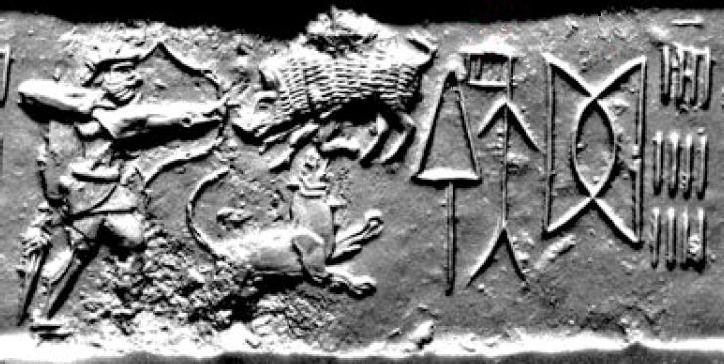
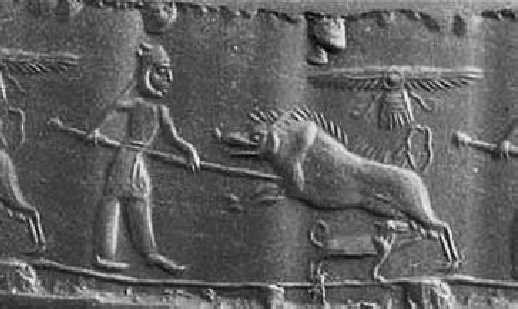
So Indra is the hunter, the Goddess Samara the dog and the boar Vrsakapi/Vritra, not easy to make sense of but important to note the boars relationship to the Heavenly waters, whether in terms of somehow blocking them or swallowing them up, Delphinus is in that watery quadrant of the skies, near Aquarius and Capricorn.
the source for the water that feeds the roots is drawn off at Scorpio-Sagittarius, it could also perhaps be seen to evaporate off at the upper levels feeding back into the river/Milky Way at Taurus-Gemini
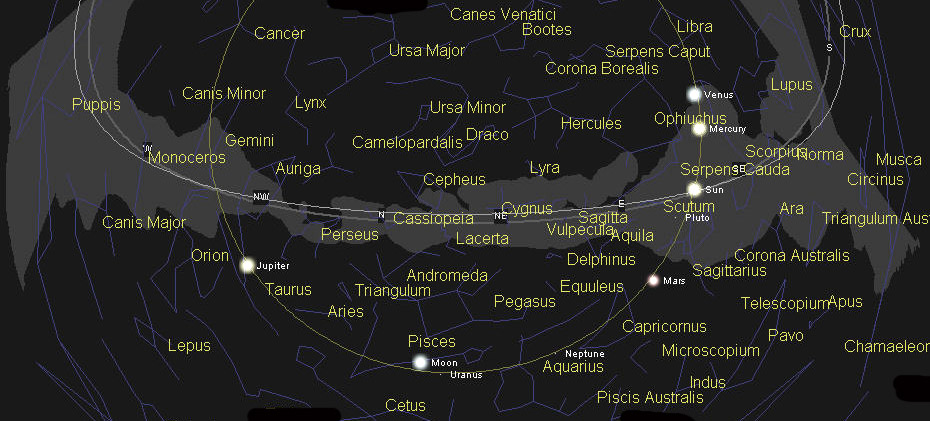
a reply to: Abysha
I'm great at things that seemingly have no practical use...
It is incredible, this magico-religious system when properly understood is more sophisticated than any other, the two lowest sections the boar constellation Delphinus regulating the supply of water from Scorpio at the Milky way can be sourced through the Rig Veda;

"Thou, Indra, heedless passest by the ill Vrsakapi hath wrought;
What hath he done to injure thee, this tawny beast Vrsakapi,
Soon may the hound who hunts the boar seize him and bite him
All these things Visnu brought, the Lord of ample stride whom thou hadst sent-
A hundred buffaloes, a brew of rice and milk: and Indra, slew the ravening boar
He smote away the floods' obstructer, Vritra; Earth, conscious, lent her aid to speed thy thunder.
Thou sentest forth the waters of the ocean, as Lord through power and might, O daring Hero.
When, Much-invoked! the water's rock thou cleftest, Sarama showed herself and went before thee
Indra, at thine exploit. Vritra, the boar who lay amid the waters to sleep thou sentest with thy mighty thunder.

So Indra is the hunter, the Goddess Samara the dog and the boar Vrsakapi/Vritra, not easy to make sense of but important to note the boars relationship to the Heavenly waters, whether in terms of somehow blocking them or swallowing them up, Delphinus is in that watery quadrant of the skies, near Aquarius and Capricorn.
In Hindu mythology, Sarama (The Runner) is a mythological being referred to as the bitch of the gods, or Deva-shuni.
She is described as the mother of all dogs, in particular of the two four-eyed brindle dogs of the god Yama, and dogs are given the matronymic Sarameya ("offspring of Sarama"). One scripture further describes Sarama as the mother of all wild animals.
the source for the water that feeds the roots is drawn off at Scorpio-Sagittarius, it could also perhaps be seen to evaporate off at the upper levels feeding back into the river/Milky Way at Taurus-Gemini

a reply to: Abysha
I'm great at things that seemingly have no practical use...
edit on Kpm33167vAmerica/ChicagoTuesday0831 by Kantzveldt because: (no reason
given)
Back to frequency again and light the Bifröst
itmovesmemorelol.tumblr.com...
Gjallarhorn (Old Norse “yelling horn” or “loud sounding horn”) is a horn blown at the onset of Ragnarök and is associated with Heimdall.
The Gjallarhorn is mentioned in the Völuspá, where the völva foresees the events of Ragnarök and the role in which Heimdall and Gjallarhorn will play at its onset; Heimdall will raise his horn and blow loudly.
“Fast move the sons of Mim and fate
Is heard in the note of the Gjallarhorn;
Loud blows Heimdall, the horn is aloft,
In fear quake all who on Hel-roads are.”
Earlier in the same poem, the völva mentions a scenario involving the horn:
“I know of the horn of Heimdall, hidden
Under the high-reaching holy tree;
On it there pours from Valfather’s pledge
A mighty stream: would you know yet more?”
In the Gylfaginning, High tells Gangleri about Heimdall. High mentions that Heimdallr is the owner of the Gjallarhorn and that “its blast can be heard in all worlds.”
itmovesmemorelol.tumblr.com...
a reply to: SeaWorthy
The Bifrost tradition is interesting in that one does not simply see water drawn up into the tree through the underground stream and well, but that it also evaporates off at the upper level, understood to reconnect to the Milky Way at the Taurus-Gemini point of the intersection of that with the ecliptic plane.
So you have the combination of moisture particles drifting off in that general direction and this in combination with the transition of the Sun along the ecliptic plane, the two factors of light and water vapour providing the rainbow bridge that translates souls into the Heavens.
Sadly it's the case today that even those who still have an interest in the nine levels of Yggdrasil have no idea were it was understood as located within the Heavens
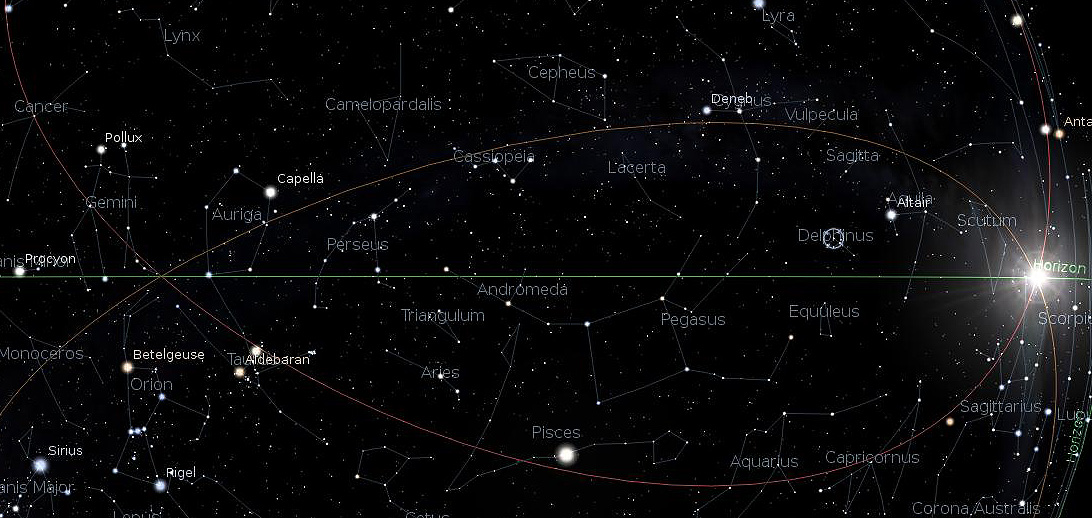
It's all explained here...
The Bifrost tradition is interesting in that one does not simply see water drawn up into the tree through the underground stream and well, but that it also evaporates off at the upper level, understood to reconnect to the Milky Way at the Taurus-Gemini point of the intersection of that with the ecliptic plane.
So you have the combination of moisture particles drifting off in that general direction and this in combination with the transition of the Sun along the ecliptic plane, the two factors of light and water vapour providing the rainbow bridge that translates souls into the Heavens.
Sadly it's the case today that even those who still have an interest in the nine levels of Yggdrasil have no idea were it was understood as located within the Heavens

It's all explained here...
edit on Kam33168vAmerica/ChicagoWednesday0931 by Kantzveldt because: (no reason given)
edit on
Kam33168vAmerica/ChicagoWednesday0931 by Kantzveldt because: (no reason given)
new topics
-
Bizarre Labour Party Tic Toc Video Becomes Even More Embarrassing
Regional Politics: 39 minutes ago -
Potter to WHU
World Sports: 6 hours ago -
Dr. Demento
Music: 8 hours ago -
The elephant in the room (wearing a hoodie)
US Political Madness: 8 hours ago
top topics
-
The elephant in the room (wearing a hoodie)
US Political Madness: 8 hours ago, 14 flags -
To become president, Zelensky had to learn Ukrainian
Political Conspiracies: 14 hours ago, 8 flags -
Dr. Demento
Music: 8 hours ago, 6 flags -
Bizarre Labour Party Tic Toc Video Becomes Even More Embarrassing
Regional Politics: 39 minutes ago, 3 flags -
Potter to WHU
World Sports: 6 hours ago, 2 flags
active topics
-
President Carter has passed
Mainstream News • 50 • : xuenchen -
Los Angeles brush fires latest: 2 blazes threaten structures, prompt evacuations
Mainstream News • 198 • : Oldcarpy2 -
What Comes After January 20th
Mainstream News • 36 • : cherokeetroy -
Bizarre Labour Party Tic Toc Video Becomes Even More Embarrassing
Regional Politics • 1 • : chiefsmom -
The Fight for Election Integrity Continues -- Audits, Criminal Investigations, Legislative Reform
2024 Elections • 4372 • : IndieA -
Potter to WHU
World Sports • 3 • : gortex -
The Truth about Migrant Crime in Britain.
Social Issues and Civil Unrest • 42 • : gortex -
Post A Funny (T&C Friendly) Pic Part IV: The LOL awakens!
General Chit Chat • 8007 • : underpass61 -
Planned Civil War In Britain May Be Triggered Soon
Social Issues and Civil Unrest • 29 • : AdultMaleHumanUK -
The elephant in the room (wearing a hoodie)
US Political Madness • 19 • : xuenchen
26

